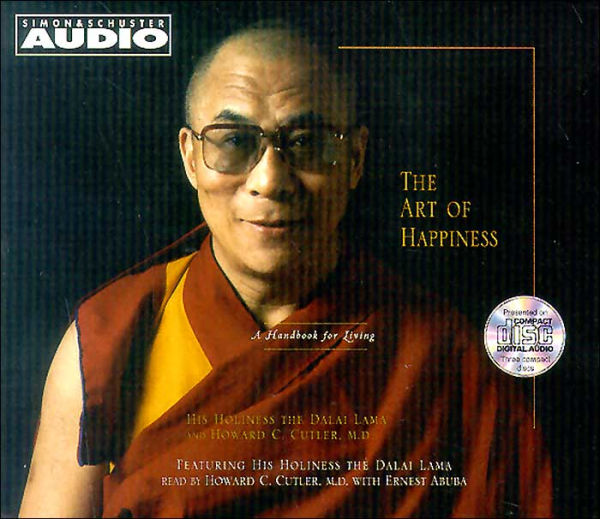Nearly every time you see him, he's laughing, or at least he's smiling. And he makes everyone else around him feel like smiling. He's the Dalai Lama, the spiritual and temporal leader of Tibet, the Nobel Prize winner, and increasingly popular speaker and statesman. Why is he so popular? Even after spending just a few minutes in his presence you can't help feeling just a little bit happier.
The Dalai Lama is probably one of the only people in the world who if you ask him if he's happy, even though he's suffered the loss of his country, will give you an unconditional "yes." What's more, he'll tell you that happiness is the purpose of life, and that "the very motion of our life is towards happiness." How to get there has always been the question. He's tried to answer it before, but he's never had the help of a psychiatrist to get the message across in a context we can easily understand.
Through meditations, stories and the meeting of Buddhism and psychology, the Dalai Lama shows us how to defeat day-to-day depression, anxiety, anger, jealousy, or just an ordinary bad mood. He discusses relationships, health, family, work, and spirituality to show us how to ride through life's obstacles on a deep abiding source of inner peace. Based on 2500 years of Buddhist meditations mixed with a healthy dose of common sense, The Art of Happiness is an audiobook that crosses the boundaries of all traditions to help listeners with the difficulties common to all human beings.
1102538670
The Dalai Lama is probably one of the only people in the world who if you ask him if he's happy, even though he's suffered the loss of his country, will give you an unconditional "yes." What's more, he'll tell you that happiness is the purpose of life, and that "the very motion of our life is towards happiness." How to get there has always been the question. He's tried to answer it before, but he's never had the help of a psychiatrist to get the message across in a context we can easily understand.
Through meditations, stories and the meeting of Buddhism and psychology, the Dalai Lama shows us how to defeat day-to-day depression, anxiety, anger, jealousy, or just an ordinary bad mood. He discusses relationships, health, family, work, and spirituality to show us how to ride through life's obstacles on a deep abiding source of inner peace. Based on 2500 years of Buddhist meditations mixed with a healthy dose of common sense, The Art of Happiness is an audiobook that crosses the boundaries of all traditions to help listeners with the difficulties common to all human beings.
The Art Of Happiness: A Handbook For Living
Nearly every time you see him, he's laughing, or at least he's smiling. And he makes everyone else around him feel like smiling. He's the Dalai Lama, the spiritual and temporal leader of Tibet, the Nobel Prize winner, and increasingly popular speaker and statesman. Why is he so popular? Even after spending just a few minutes in his presence you can't help feeling just a little bit happier.
The Dalai Lama is probably one of the only people in the world who if you ask him if he's happy, even though he's suffered the loss of his country, will give you an unconditional "yes." What's more, he'll tell you that happiness is the purpose of life, and that "the very motion of our life is towards happiness." How to get there has always been the question. He's tried to answer it before, but he's never had the help of a psychiatrist to get the message across in a context we can easily understand.
Through meditations, stories and the meeting of Buddhism and psychology, the Dalai Lama shows us how to defeat day-to-day depression, anxiety, anger, jealousy, or just an ordinary bad mood. He discusses relationships, health, family, work, and spirituality to show us how to ride through life's obstacles on a deep abiding source of inner peace. Based on 2500 years of Buddhist meditations mixed with a healthy dose of common sense, The Art of Happiness is an audiobook that crosses the boundaries of all traditions to help listeners with the difficulties common to all human beings.
The Dalai Lama is probably one of the only people in the world who if you ask him if he's happy, even though he's suffered the loss of his country, will give you an unconditional "yes." What's more, he'll tell you that happiness is the purpose of life, and that "the very motion of our life is towards happiness." How to get there has always been the question. He's tried to answer it before, but he's never had the help of a psychiatrist to get the message across in a context we can easily understand.
Through meditations, stories and the meeting of Buddhism and psychology, the Dalai Lama shows us how to defeat day-to-day depression, anxiety, anger, jealousy, or just an ordinary bad mood. He discusses relationships, health, family, work, and spirituality to show us how to ride through life's obstacles on a deep abiding source of inner peace. Based on 2500 years of Buddhist meditations mixed with a healthy dose of common sense, The Art of Happiness is an audiobook that crosses the boundaries of all traditions to help listeners with the difficulties common to all human beings.
25.0
In Stock
5
1

The Art Of Happiness: A Handbook For Living
25.0
In Stock

Product Details
| ISBN-13: | 9780743506304 |
|---|---|
| Publisher: | Simon & Schuster Audio |
| Publication date: | 11/01/1998 |
| Edition description: | Abridged |
| Product dimensions: | 5.00(w) x 5.75(h) x 1.00(d) |
About the Author
From the B&N Reads Blog
